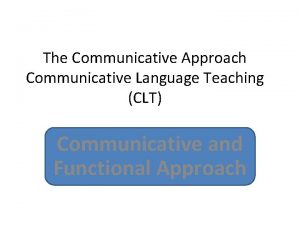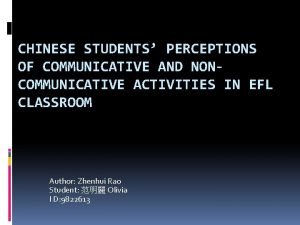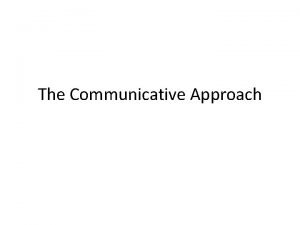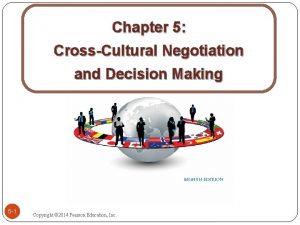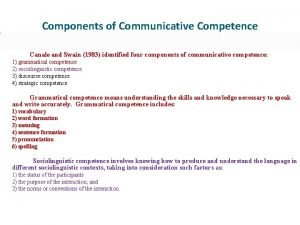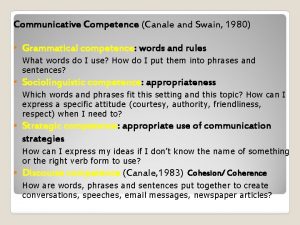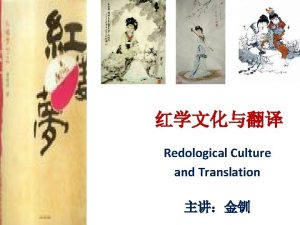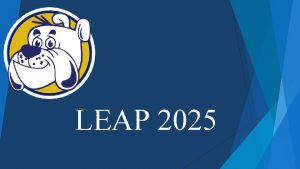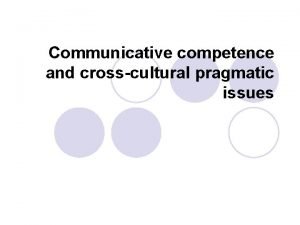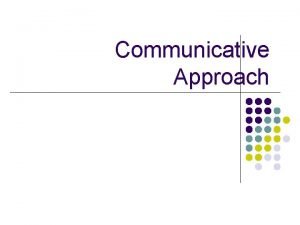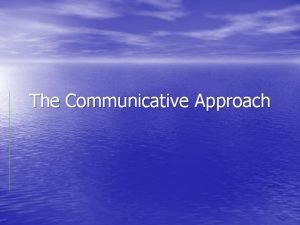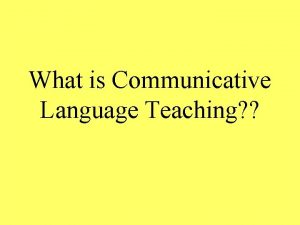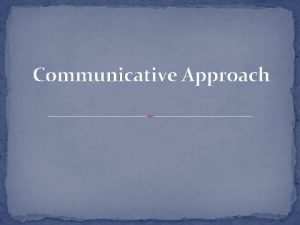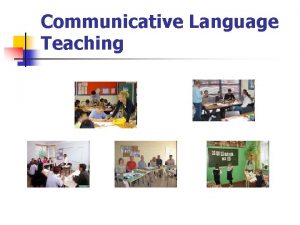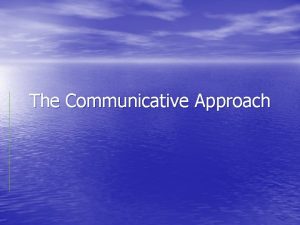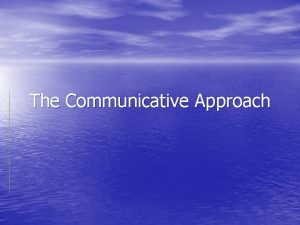MAKING THE LEAP DEVELOPING COMMUNICATIVE AND CULTURAL ACTIVITIES
















- Slides: 16

MAKING THE LEAP: DEVELOPING COMMUNICATIVE AND CULTURAL ACTIVITIES FOR PETRONIUS’ SATYRICA John Gruber-Miller, Cornell College

Overview Holistic Language Learning Why Petronius? Examples of Pre-reading activities Sample Post-reading Activities Foods of Roman daily life How to create your own exercises

Holistic Language Learning If we think of language as a form of communication, then our students will want to converse about a topic, interpret a text, and make presentations Students learn best when they use the language actively—listening, speaking, reading, and writing Students learn best when they are given activities that play into their various learning styles

Why Petronius? Petronius’ Satyrica is rich with cultural elements that are inherently interesting Petronius’ text introduces students to important aspects of daily life that will prepare them to read other texts Petronius’ text helps them become better readers as they learn to see how discourse is structured and how diction affects interpretation Syntactically Petronius is not as complex as other texts Generically, it focuses on narrative and description

Language and Culture Intertwined Culture is mediated by language and constructed by patterns of discourse Language in its lexical, grammatical, syntactic, rhetorical, and generic constructions inextricably shapes the stories and cultural narratives that a culture tells about itself “stories another culture tells about itself”

Becoming a Proficient Reader Bottom-Up/Lower-level/Textual Processes � Word recognition � Morphosyntactic information � Text cohesion (e. g. , pronouns, conjunctions, synonyms) � Text structure Top-Down/Higher-level/Reader-based Processes � Knowledge of the world � Cultural knowledge � General literacy skills

Text-based Processes: Word Recognition When we read in L 1, we focus on 80% of content words and 50% of small function words We often recognize a word in less than 100 milliseconds We can read a text comfortably at 250 -300 words/min. “In order for fluent word recognition to occur, a reader must recognize the word forms on the page very quickly, activate links between the graphic form and phonological information, activate appropriate semantic and syntactic resources, recognize morphological affixation in more complex word forms, and access her or his mental lexicon. ”

Bernhardt’s Compensatory Model of L 2 Reading

Kern: Seven Principles of Literacy Elements to be taught Language Conventions Cultural knowledge Processes Interpretation Collaboration Problem solving Reflection

Examples of a reading lesson Pre-reading for Chapter 2 of Severy-Hoven � Parts of a house: Inside the Roman house. After watching the slide show three times (teacher-narrated, student-narrated, and without super titles), ask students questions about certain rooms � Review of the ablative: Quomodo vides? Post-reading � Draw a picture of the wall painting in 29. 3 -6 and label the elements. Where does the wall painting end actual objects appear? � How would this passage serve as a satiric version of a Roman triumph or Aeneas’ viewing of the Temple of Juno at Carthage? � Identify the ablatives in the same passage or in 31. 3 -6

Food of Roman daily life Each student (or pair of students) is assigned a food group (see the Prezis on the webpage) and then answers the following questions about it: where is it produced? Ubi crescit? how is it harvested? Quomodo colligitur? metitur? how is it prepared/stored? Quomodo paratur? at what meal is it eaten? ientaculo an prandio an cena consumitur? what social groups usually eat it? Quis saepe id edit?

How to design your own activities Choose the passage and then ask the following questions: What vocabulary does a reader need to know to read this passage? What grammar is repeated that is needed to read the passage? What cultural context can the passage be placed into? How can the activity be enhanced visually, aurally, or kinesthetically?

Post-Reading Activities: Vocabulary Complete a chart about values, traits, types of buildings Link monuments with builders, reasons for building, location Identify the 10 most important words Label a drawing Find synonyms: create Greek-Greek dictionary

Post-Reading Activities: Syntax Complete a cloze exercise Find subordinate ideas (e. g. , participial phrases, indirect statements, other clauses) Rewrite subordinate ideas into independent clauses Put jumbled sentences in order Describe a picture, monument, or space with prepositions

Post-Reading Activities: Summary Summarize the passage Draw a cartoon with bubble quotations Write out the itinerary in a table Label the itinerary on a plan Make a drawing of the “word picture” Create a family tree Complete information-gap activity Annotate locations on a map

Writing with Authority Learn to write in various genres: encyclopedia article, handbook, narrative, description, and history Encyclopedia entry: � Locate a person, work, or event in a historical (topographical) setting, � provide an account of its origin, relevant events or details, and products or results � Will present a master narrative
 Picture strip story in communicative language teaching
Picture strip story in communicative language teaching Non communicative activities
Non communicative activities What is the communicative approach
What is the communicative approach Indoor sports and outdoor sports
Indoor sports and outdoor sports Support activities and primary activities
Support activities and primary activities Tertiary activities definition
Tertiary activities definition Cross cultural negotiation and decision making
Cross cultural negotiation and decision making War making and state making as organized crime summary
War making and state making as organized crime summary The statement of cash flows helps users
The statement of cash flows helps users What is inferring
What is inferring What is semantic translation
What is semantic translation Four components of communicative competence
Four components of communicative competence Communicative comptence
Communicative comptence Communicative signals and informative signals
Communicative signals and informative signals Informative signals example
Informative signals example Communicative and informative signals
Communicative and informative signals Semantic vs communicative translation
Semantic vs communicative translation
